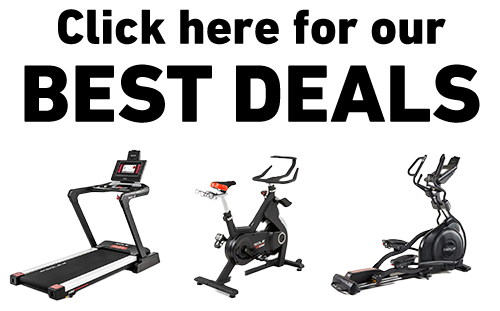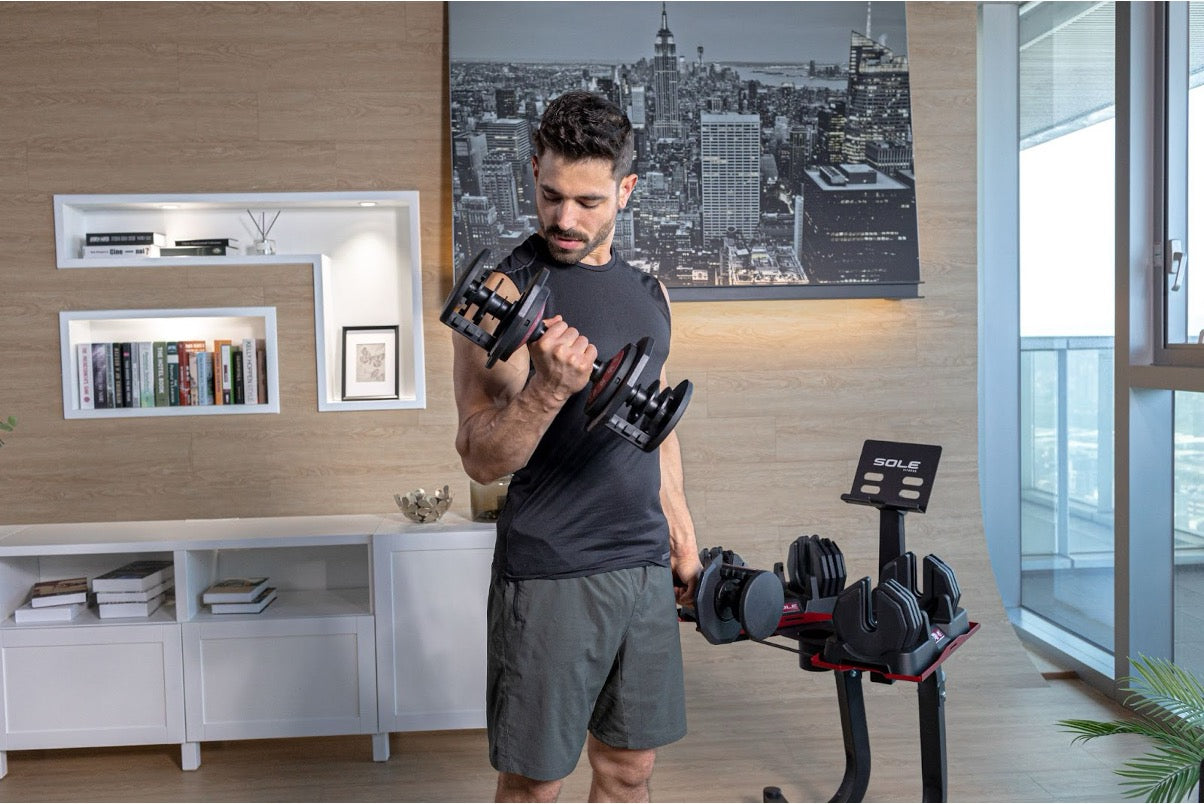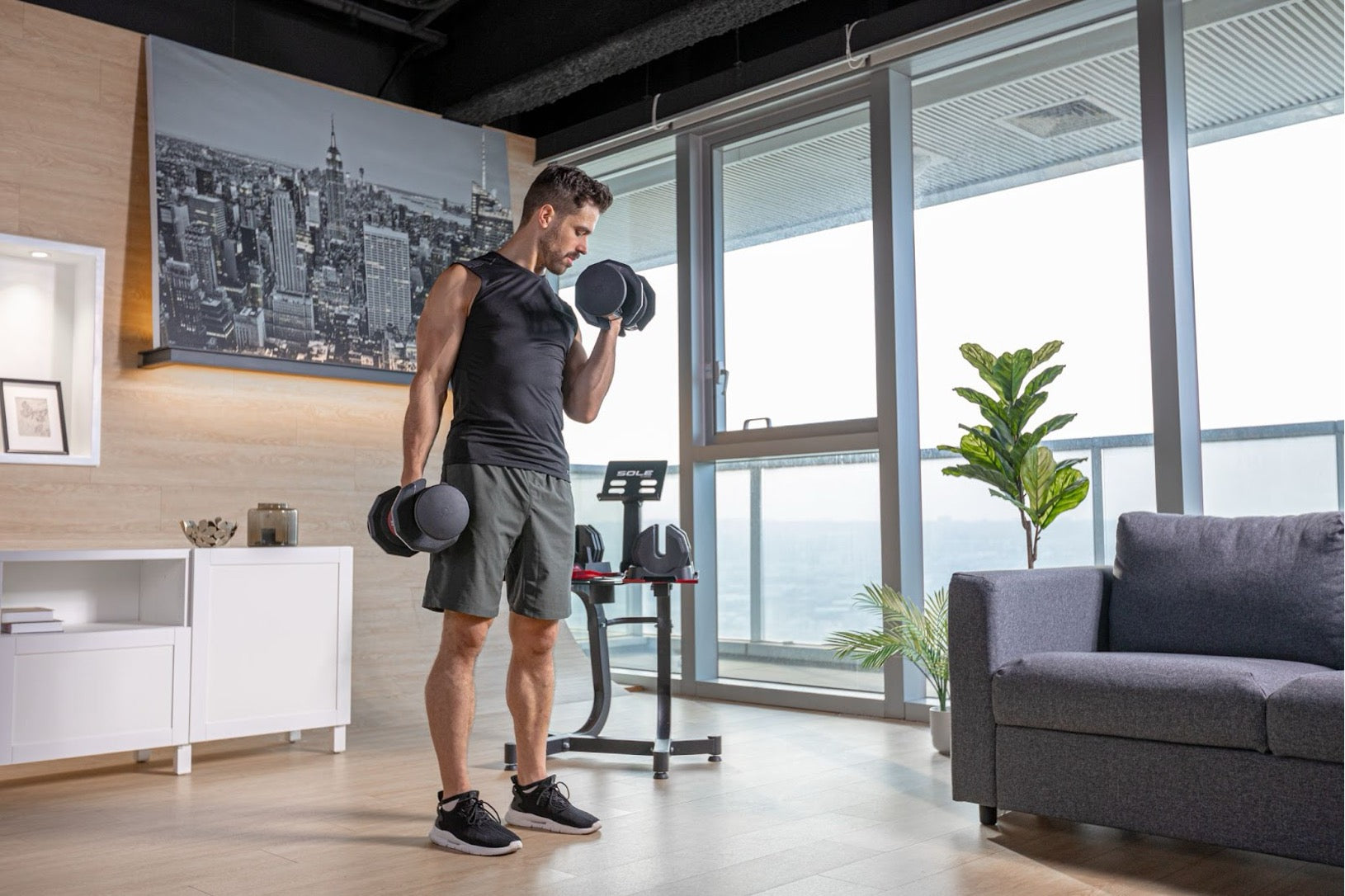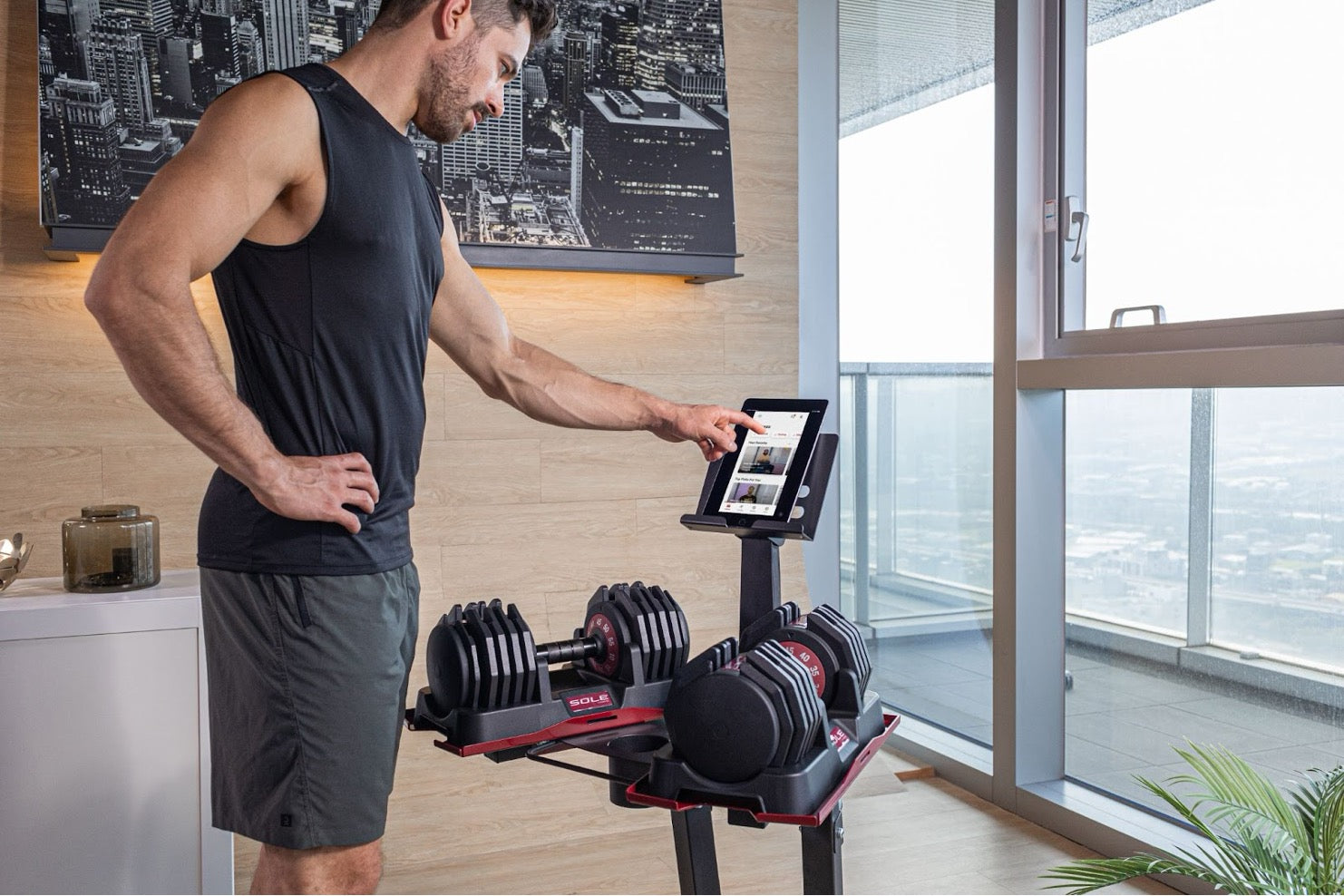Key Takeaways
- Circuit training with dumbbells is a fast-paced workout where you move between different exercises using dumbbells, targeting multiple muscle groups while keeping your heart rate up.
- Dumbbell circuit training can be done in as little as 20 minutes, making it perfect for busy schedules.
- This type of workout can improve both strength and cardiovascular fitness simultaneously.
- Choose dumbbell weights that challenge you but allow you to maintain proper form.
- The SOLE SW101 Dumbbell Set is perfect for circuit training, letting you switch between weights (10–40 lbs) fast, so you keep moving without missing a beat between exercises.
Can You Do Circuit Training with Dumbbells?
Yes, you can absolutely do circuit training with dumbbells! Dumbbell circuit training is all about moving through a series of exercises with minimal rest, using dumbbells to add resistance.
It’s a great way to build strength, burn calories, and keep your heart rate up—all in one workout.
You’ll typically switch between upper body, lower body, and core exercises, making it a full-body challenge.
Why Choose Dumbbells
- Space-Saving & Affordable: They don’t take up much room and are a cost-effective alternative to bulky gym machines.
- Full-Body Activation: Unlike machines that target just one muscle, dumbbells engage multiple muscle groups at once.
- Natural Movement: They allow for a more natural range of motion, which helps build strength while improving flexibility.
- Better Balance & Coordination: Since they’re not fixed like machines, your body has to work harder to stay stable, engaging your core and improving overall coordination.
Benefits of Dumbbell Circuits
- Super Versatile: You can target multiple muscle groups in a short amount of time, making your workout efficient and effective.
- Boosts Strength & Cardio: Moving quickly between exercises keeps your heart rate up, so you're not just building muscle—you’re also burning calories and improving cardiovascular health.
- Workout Anywhere: Whether you're at home, in a gym, or even at the park, all you need is a pair of dumbbells—no expensive equipment or memberships required.
|
At SOLE, we're proud to offer top-quality exercise equipment designed for home and gym use. Our machines are built to meet the highest standards of durability and performance, making them ideal for fitness enthusiasts at any level. SOLE Products
|
Quick Dumbbell Circuit Training Workout
Here's an example of a dumbbell circuit training workout routine that you can follow.
Picture doing some squats, then smashing out some push-ups, lunging around, and finishing with shoulder presses.
You do each move for a certain amount of time or reps, take a quick breather, then go through it all again. Easy peasy!
1. Set Up Your Routine
Essential Equipment
Here's the stuff you'll need to get going:
- A pair of dumbbells (adjustable ones are super handy if you're just starting out)
- A mat or soft surface for floor exercises
- A timer or stopwatch to keep track of your intervals
- A towel and water bottle so you don't dehydrate
Once you've got your gear, it's time to figure out the right weight for your dumbbells.
Choosing Dumbbell Weight
Picking the right weight is super important if you want to get the most out of your workout. You want something heavy enough to challenge you but not so heavy that your form goes to crap.
A good rule is to start with a weight that lets you do 8-12 reps with decent form. If you're struggling to finish, go lighter. If it feels like nothing, grab something heavier.
And hey, it's totally fine to use different weights for different exercises. You might need baby weights for shoulder presses but something beefier for squats. Just listen to your body and adjust as you go.
2. Upper Body Moves
Let's talk about upper body workouts. With dumbbells, you can blast your arms, shoulders, chest, and back with all kinds of exercises.
One great example is the dumbbell bench press. It's a classic move that works your chest and triceps.
Just lie on a bench or the floor, hold the dumbbells above your chest, and push 'em up. Keep your elbows slightly bent so you don't lock them out and hurt yourself.
Another good one is the bent-over row. This one hits your back and biceps. Stand with your feet shoulder-width apart, bend at the hips, and keep your back straight (no hunching!).
Hold the dumbbells with your palms facing in, and pull 'em towards your waist. Squeeze those shoulder blades together at the top for maximum effect!
3. Lower Body Moves
Moving down to the lower body - squats are non-negotiable! They work your quads, hamstrings, and glutes all at once.
Hold a dumbbell in each hand at your sides, stand with your feet hip-width apart, and lower your booty like you're sitting in an invisible chair. Keep your chest up and your knees behind your toes. Push through your heels to stand back up.
Lunges are another awesome pick. They work the same muscles as squats while challenging your balance (hello, core workout!). Step forward with one foot, drop your body until your front thigh is parallel to the floor, then push back to start. Switch legs to keep things even.
4. Core Strength Exercises
Dumbbell Russian twists are a good way to fire up your obliques. Just sit on the floor, knees bent, lean back a little, and clutch a dumbbell. Twist right, twist left, and keep that core tight the whole time (image courtesy of Women’s Fitness).
Planks with dumbbell rows will have your core toned. Get yourself in plank mode with dumbbells in your hands. Row one up to your hip while the rest of you stays locked down, and then flip sides.
5. Cool Down and Stretch
After a high-intensity circuit, cooling down is super important. It helps your body chill out and cuts down on muscle soreness. Start with a few minutes of easy cardio, like walking or light jogging, to bring your heart rate down.
Next, stretch all your major muscle groups. Focus on your shoulders, chest, back, quads, hamstrings, and calves. Hold each stretch for at least 15-30 seconds, and don't forget to breathe! Stretching helps with flexibility and recovery.
- Standing quad stretch: Grab your ankle behind you and pull it toward your butt
- Hamstring stretch: Sit on the floor, extend one leg, and reach for your toes
- Chest stretch: Stand in a doorway, put your arms on the frame, and lean forward
Finally, take a sec to relax and think about your workout. Give yourself props for working hard and set some goals for next time.
Tips for Success
Maintaining Form
Good form prevents injuries and makes sure you're working the right muscles. Always start lighter if you're not sure about your form. Use mirrors to check yourself out, and don't rush through the moves. Quality beats quantity every time!
Progressive Overload Techniques
Progressive overload is key if you want to keep seeing results. This basically means gradually making your workouts harder over time.
You might start with 5-pound dumbbells and work up to 10 pounds as you get stronger. Or you could add more sets or cut down rest time between exercises.
Keep tabs on your progress and challenge yourself regularly. This keeps things interesting and makes sure you're always improving.
Tracking Your Progress
Tracking your progress is important for any fitness journey. It keeps you motivated and lets you see how far you've come! Start by setting clear goals that you can actually achieve.
Whether it's lifting heavier, boosting your endurance, or just having more energy, having something to aim for keeps you focused.
Keep a workout journal or use a fitness app to log your exercises, weights, and reps. Over time, you'll notice patterns and improvements. Celebrate the small wins, like finishing an extra set or shaving time off your circuit. These little victories add up to big results!
Elevate Your Workouts With SOLE
Your workouts can get easier just by using the right equipment. Lift iron the right way!
With SOLE Fitness dumbbells, circuit training becomes more efficient, effective, and enjoyable. This set includes pairs of dumbbells at 10, 15, 20, 25, 30, 35, and 40 pounds - so you can easily switch up the weight to match your workout intensity.
Each dumbbell features a knurled ergonomic handle, giving you a comfy and secure grip—even when you're sweating it out.
Plus, their hexagonal, rubber-coated design means they won't roll away between sets, keeping your workout space safe and organized.
Whether you're squeezing in a quick session or pushing your limits with high-intensity circuits, our dumbbells give you the versatility and durability you need to train smarter and get stronger.
Check out our SOLE dumbbells now!
Frequently Asked Questions (FAQ)
How often should I do circuit training?
Circuit training is super flexible, and you can fit it into your schedule however works for you. For most people, 2-3 times a week is perfect.
This gives your muscles time to recover while still keeping up with consistent workouts. If you're doing other stuff like running or cycling, just adjust so you don't overtrain and burn out.
Can beginners do dumbbell circuits?
Heck yeah! Dumbbell circuits are awesome for beginners because you can modify them for any fitness level. Start with lighter weights and simpler exercises, focusing on getting the form right.
As you get stronger and more confident, gradually make your workouts more complex and intense.
What is the ideal dumbbell weight for starters?
For beginners, starting with 5-10 pounds is usually a good bet. The goal is to pick a weight that challenges you without wrecking your form. If you can breeze through your reps, it's time to level up!
Remember, it's totally normal to use different weights for different exercises. Your legs can probably handle way more weight than your arms, for instance.
That’s where SOLE’s dumbbells come in. The full set includes pairs of dumbbells ranging from 10 to 40 lbs in 5 lb increments, giving you everything you need for a versatile workout right at home—no gym necessary.
How long should each circuit last?
A typical circuit can run anywhere from 15 to 30 minutes, depending on how many exercises you're doing and how fit you are. Usually, you'd do each exercise for 30-60 seconds, take a quick breather, then move to the next one. Go through the whole circuit 2-3 times for a complete workout.
As you get fitter, you can make your circuits longer or more intense for bigger challenges.




Leave a comment
This site is protected by hCaptcha and the hCaptcha Privacy Policy and Terms of Service apply.